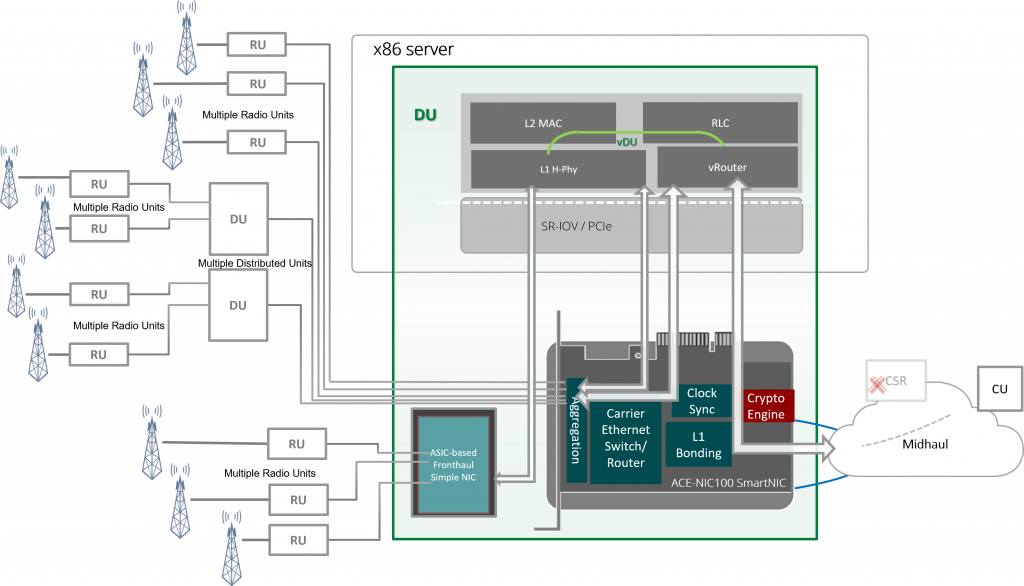
When Ethernity announced its 5G DU Aggregation and vRouter solution in October 2020, we knew it was a gamechanger for the Open RAN market. It offered Open RAN network builders the ability to transfer timing to Radio Units (RU) and made it possible to aggregate several Distributed Units (DU) on the same site to further increase the power to aggregate data as it arrived from the RUs.
Moreover, thanks to Ethernity’s unique Router-on-NIC feature, it embedded MEF 3.0-compliant Carrier Ethernet services, it allowed better DU network control for a centralized router, and, in certain deployments, it allowed the use of the Ethernity SmartNIC and software stack as the actual Cell Site Router (CSR). Thus, the data could be routed toward the Centralized Units (CUs) directly within the DU itself, eliminating the need for external CSRs attached to the DU.
This solution is so remarkably groundbreaking that it earned a shortlist nomination for a GLOMO Award from the GSMA.
The question of whether Open RAN will actually occur or whether the mobile network will continue to be dominated by end-to-end monolithic network suppliers is still relevant. But recently, we have seen larger semiconductor companies, like Qualcomm, Nvidia, and Intel, presenting roadmap plans to develop ASICs for DU that support the Open RAN network model framework. This is an encouraging sign for the market potential of disaggregated Open RAN products and solutions.
The planned ASIC-based fronthaul cards support certain fixed functionality for Layer 1 processing, fronthaul aggregation, and sync, but they leave the L2/L3 functions that are at the heart of Ethernity’s domain for further innovation and virtualization. This is a positive development that will further reduce the cost of Open RAN so that it is economically viable for operator deployment compared to the current monolithic mobile network.
However, beyond the handling of fronthaul traffic and Layer 1 processing (which can be handled by ASICs), a DU must also connect to the midhaul with support for Carrier Ethernet functions (such as OAM and BFD), aggregate traffic from other DUs at the same location, and extract timing information from the midhaul network to drive that information to RUs and other DUs. These advanced functions are supported by Ethernity’s programmable SmartNIC but are not part of the ASIC offering. The ASIC-based cards serve a vital role, but they cannot offer the advanced networking and critical features that operators value when building their networks and that Ethernity’s ACE-NIC100 provides for midhaul. And that is before you add in the routing that Ethernity embeds into its FPGA NIC and applies to the midhaul connection between the DU and the various CUs spread across the Open RAN network.
Moreover, Ethernity proposes its vRouter offload to add secure tunnels from the DU to the CU by utilizing the security functionality available within the ENET Flow Processor engine suite.
A notable element in Ethernity’s FPGA SmartNIC for DU is the ability to support 12 Ethernet ports (25G/10G or GbE) that can utilize our new patented wireless bonding technology to implement microwave aggregation on the ACE-NIC100 within the DU. This implementation is essential for microwave connectivity, easing deployment of Open RAN wireless connectivity.
Why add another external box that handles all the microwave connections and networking and only send the data to the DU thereafter? It can simply be embedded into Ethernity’s FPGA SmartNIC.
Ethernity’s DU solution provides the ability to aggregate the microwave links from multiple RUs, cascades multiple DUs, adds Carrier Ethernet switching with all its advanced features, and offers a router directly within the DU.
Let’s even go one step further… The CU aggregates multiple DUs and then must handle up to 100G of IPSec before it can send the data onward toward the network core. But why handle all of that security there, when it’s possible to distribute the security across the many DUs?
Ethernity offers this distributed security offload by offering IPSec as one of its many programmable features for the ACE-NIC100 within its DU solution. ACE-NICs can perform IPSec operations on the data within the DUs, offloading the functionality from the CUs and easing potential bottlenecks in the data flow.
By adding extra networking and security within the DU, Ethernity makes Open RAN easier for operators to deploy. By enabling network builders to customize the features on top of their standard DU offering, there is freedom of choice within the platform.
Ultimately, an OEM or system integrator can opt to use only the simple fronthaul NICs, but then the system will require the same old external devices to handle the Carrier Ethernet switching, the routing, the microwave aggregation, and the crypto. In other words, there is no real Open RAN in such a system. But with Ethernity’s ACE-NIC added into the DU server, all those external devices are now incorporated into a value-added system that offers unprecedented agility and true savings to the operators.
Another example of this is the OpenSoftHaul project sponsored by TIP, which is advocating for a disaggregated white box Indoor Unit (IDU), using wireless backhaul. Ethernity’s ACE-NIC offering embeds the IDU functions with the addition of Layer 1 bonding to provide further savings for the operator, and can be used in conjunction with our Wireless Backhaul solution, which is based on using our Universal Edge Platform devices as an aggregation point.
That freedom of choice is the very foundation of disaggregated networking: the ability to use interoperable best-in-class products and solutions and avoid vendor lock-in, thereby gaining agility without compromising on performance.
This is the unique proposition of a truly programmable solution for networking and security. This is the unique advantage offered by Ethernity.

By Brian Klaff

